 |
| Poggio di Sotto |
21 Dec 2012
Recapturing the vibe (Montalcino, Italy - Day Two)
It’s such a relief to simply be in holiday mode after most of the past 14 months have been spent not only travelling but researching and arranging appointments and then writing as much as I can. I have joined my parents who have flown up from Melbourne for us to travel in Italy for my last six weeks in Europe. Not only is this a great experience for me not having seen them for over 14 months, but also my mother brought me as a baby to Italy for five months whilst she worked on her masters in a dialect from Campania. I may have mentioned in a post back in April that I was actually returning to Italy after almost 30 years, and now my mother and I are reunited in Italy as well. As I am travelling I won’t be doing much writing in the hope of making the most of the trip with my parents, but they are interested to visit a few wineries whilst we are here so I will write about them. I raved to them about how beautiful Montalcino was, and as we were staying a few nights in Siena to the north and we were passing through, I made an appointment to a winery that I didn’t visit when I was here before.
19 Dec 2012
Impressions of France
 |
| Day 1 in French wine country |
16 Dec 2012
Here endeth the lesson (Beaujolais, France)
Fourteen and some months after I left Australia I arrived at my last day visiting wineries, and it certainly has been quite a journey. As it turns out I am very glad to be finishing in Burgundy, partly because I generally love the wines and they are amongst my favourite in Europe, but also as Burgundy is such a diverse and often complicated region that I was glad to have had all the previous experience before visiting. Having already visited the Chablis and the Cote d’Or on my previous trip in 2010 there was very little that surprised me in these regions and it was more a question of familiarising myself further. South of the Cote de Beaune on the other hand was a different story, as not only did I know very little about these appelations but I had had almost no tasting experience with them. Unfortunately I wasn't able to secure any appointments either in the Cote Challonaise or the Cote Maconnaise and had to be content with driving through parts of the area to see the type of landscape it is. One of the more famous appelations in the Cote Maconnaise is the village of Chardonnay, not because of the quality of the wines but because it is supposedly the birthplace of possibly my favourite white grape variety. Technically still part of Macon but a different appelation to the south is the famous Beaujolais which totally took me by surprise, and I was pretty happy to finish somewhere that did. The king of varieties here is gamay, and there are no other parts of the world that grow it in the quantity or quality they do here. There is a separate appelation for Beaujolais Blanc wines which are 100% chardonnay, but really it’s the gamay that makes this region what it is.
 |
| A cold day in Beaujolais |
12 Dec 2012
So good they named it twice (Cote de Beaune, France – Day Two)
The famous village of Chateauneuf-du-Pape wasn't always named as such, it was renamed from just Chateauneuf after the Papal regime had all of their best vineyards here back in the 15th century. The association with this important period in history was strong enough to change the name of the village, thereby highlighting the importance of viticulture, and today it is the largest single appelation in France. This isn't the only village in France that has changed its name to signify the importance of viticulture, some of the most famous are in Burgundy. Within the Cote d’Or, villages that neighboured the best grand cru vineyards began to take the name of the vineyard to lift their profile. Gevrey became Gevrey-Chambertin, Chambolle became Chambolle-Musigny, Vosne became Vosne-Romanee and Aloxe became Aloxe Corton. Arguably the most famous white wines in the world come from the Montrachet Grand Cru vineyards which are between the villages of Puligny and Chassagne, and thus they both took the name of the vineyard and became Puligny-Montrachet and Chassagne-Montrachet respectively. In a way this is like a seal of approval or a sponsorship, but in the same way that a sponsorship from Pepsi doesn't guarantee that The Spice Girls are good, just because the fruit comes from a classified vineyard it doesn't mean it will be the same style or the same quality. This is one of the problems with the appelation classification system, is that it is merely for a place and not for the human influence, and two wines from the same vineyard but a different producer can be very different. As I always say, trust the producer first and the rest will follow.
 |
| Barrels and bottles |
A Beaune to pick (Cote de Beaune, France - Day One)
Something that amazed me when I first came to Burgundy back in 2010 was how small the region was compared to how important it was, particularly in comparison to Bordeaux which is as big as it is important. The Cote d’Or stretches for about 40 kilometres from North-East to South-West, and is as narrow as 500 metres wide in such places as Premeaux-Prissey. The amount of wine that is produced can’t be that much considering the yields of only a few tonnes per hectare, and yet you can find Burgundy all around the world. Despite the relatively small size of the region there are a lot of differences between each part, particularly between the Cote des Nuits and the Cote de Beaune. The Cote de Beaunes starts in Aloxe-Corton, stretches north of the town of Beaune (the heart of the Cote d’Or) and continues past it all the way to just past Chassagne-Montrachet. I was always confused by the claim that the red wines of the Cote des Nuits were more feminine than their counterparts further south, whereas I (and several of my fellow students at university) felt the opposite was true. Pinot noir from the Cote de Beaune is first and foremost lighter, more pure and fresh, shows the minerality better and most importantly is more approachable sooner. I much prefer the red wines of the Cote de Beaune for all of these reasons, but it is also the chardonnay wines that distinguish this part of Burgundy as supreme, with the Montrachet Grand Cru parcels producing arguably the best white wines in the world. I was thrilled to visit three producers today that all exemplify the style of the Cote des Beaune yet have their own unique expression of it.
 |
| Ma Cuisine, one of the best dining experiences of my trip |
10 Dec 2012
What goes around (Cote des Nuits, France – Day Three)
Now that winter has arrived I feel like I've come full circle in Europe because I arrived mid January in Paris. Back in February when I was in Germany you may remember that the temperature dropped well below zero and there was quite a bit of snow in regions like the Mosel, Rheingau and Franken. The morning of my third day in the Cote d’Or I awoke to falling snow that continued all morning and covered the cars, houses and buildings quite beautifully. It also made driving a little more challenging both for visibility reasons but also as the road was a little slippery. Seeing this just reinforces the fact that these wine regions North of the Loire Valley really are very cool-climate, and you would very rarely see snow in any regions in Australia, even further south in Tasmania. These cold temperatures and snow or frost are of course the reason that grape vines go into dormancy by turning brown and into canes, to protect themselves. It’s a shame that humans can’t develop a hard exterior that perfectly protects them over the winter, we would save a fortune on heating expenses, warm clothes and car problems. My final day in the Cote des Nuits I visited three small producers all with a different approach and expression.
 |
| Nuits-St-George vineyards under snow |
9 Dec 2012
Expressions of interest (Cote des Nuits, France - Day Two)
 |
| Water is an important resource for wine production |
Chalk and cheese (Cote des Nuits, France - Day One)
 |
| They use these at Louis Jadot to indicate when they have tasted from a barrel and it needs topping up |
5 Dec 2012
Keep it simple (Chablis, France – Day Two)
If anyone has played competitive team sport in their life they may have heard of the KIS principle, which stand for Keep It Simple. Looking back on my trip I am finding it fascinating that many of the wineries and regions that I most connected with have this same principle in mind. Even more interesting is that this connection was regardless of red or white wine, but applied to philosophies and practices as well as style. The clarity purity and minerality of the rieslings I tasted in Germany blew me away, as did the gruner veltliners in Austria. Some of the best wines I tasted in Spain were those that were straightforward and approachable, such as the albarinos in Rias Baixas and the verdejos in Rueda. In terms of French wine, the simple white wines of the Loire Valley and Chablis have a special place in my heart, as the minimal intervention they make in the wineries means it is purely the expression of the variety in their particular terroir. In fact there are a number of similarities in terms of climate and soil composition between Sancerre, Pouilly and Chablis, but the latter chooses to express through chardonnay rather than sauvignon blanc. The minerality of these regions is legendary, but I am starting to see there are some different expressions that still follow the KIS principle.
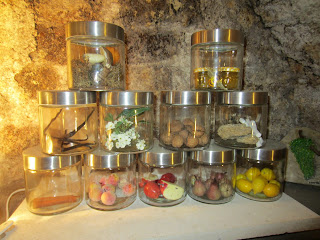 |
| Some of the characters of Chablis |
4 Dec 2012
The name game (Chablis, France - Day One)
 |
| Limestone clay and a bit of chalk |
2 Dec 2012
It is and it isn't (Pouilly, France - Day Two)
I've never really understood the phrase “the exception that proves the rule”, and I'm wondering if someone can explain it to me. Doesn't an exception by definition DISprove a rule? Isn't that the whole point of a rule? I understand the concept of “rules were meant to be broken”, never more appropriate than when talking about the rules and regulations around appellation des origine controlee (AOC) in France, and similar denominations in other European countries. The idea that the best wines are produced from certain varieties in certain terroirs perfected over the centuries isn't the question for me. The question is the determination of yields and practices in the vineyards in cellars that are determined by this quite rigid system. In terms of planting other varieties, not only can you not label any wine made from the varieties, but the mere existence of them is forbidden. Around Europe there are mavericks looking to shake things up a bit, breaking away from the norm and attempting to disprove the rules, or prove the exception. One of these is Domaine Didier Dagueneau.
 |
| Domaine Didier Dagueneau |
1 Dec 2012
Everybody needs good neighbours (Pouilly, France - Day One)
 |
| Chateau de Nozet, the unofficial heart of Pouilly-Fume |
30 Nov 2012
Finishing big (Sancerre, France – Day Three)
It is important to remember that everything is relative, and also that there are numerous implications depending on the person and the word. Language is complicated as much as communication itself, and over the past 14 months (to the day in fact) I have had so many situations where things can have different meanings depending on audience and context. My understanding of things, not only about wine, has changed significantly and I have discovered that it is important to always clarify and speak relatively. For example, there is a word in French that will be familiar to most wine-lovers that actually has different meanings in English which are related but have different connotations. The word is ‘grand’, and in the context of vineyard classification for such regions as Burgundy and Alsace, it means ‘great’ or essentially ‘the best’. The word can also mean ‘big’ or ‘large’, which implies size rather than importance and in terms of wine, could refer to the size of vineyards or a winery for example. When a winery produces 3.5 million bottles per year in Sancerre, this is both great and large, but in the Australian context it is merely a medium-sized winery. Everything is relative. What is interesting is that in my humble opinion I began my week with the most important producer in Sancerre and finished with the largest, and the quality of the wines to decline with each estate I visited.
For my morning appointment on the third and final day in Sancerre, I visited a producer in the southern-most part of the appellation in the town of Bue. The Roger family have been growing wine in this part of the world for about 400 years, and now there are several estates carrying this name that are close or distant relatives. When Jean-Max took over the four hectares of vineyards of his branch of the family, it was the 1970s and wine (particularly Sancerre) was beginning to experience a boom, particularly in established and new export markets. From this four hectares the vineyard holdings grew to now total almost 30 hectares, around a number of the southern Sancerre villages on a couple of different soils. Today, of his three sons two of them work with him at the domaine whilst the third also works in wine in the Languedoc-Roussilon part of France in the south. All three have had experience in different parts of the world, and I met with the younger of the two who work with their father, Thibault.
Thibault first took me to some of the vineyards to show how elevation and exposition as well as soil type influence the characteristics of the wine. It is starting to get really cold now, with snow forecast for the weekend, so with the additional wind atop the hill it was a little unpleasant. At the time it was quite overcast and a little foggy, otherwise the village of Sancerre would have been visible. The domaine has recently replanted some of the vineyards on the soils which are heavier in clay to produce a new terroir wine in the future. In the vineyards they minimise the amount of work they do which includes the spraying of chemicals. In the winery the fruit is gently pressed to extract the clean fruit, and most of the wines don’t see any oak as is the trend here. They have some vineyards in an appellation closer to Bourges, Menetou-Salon where they grow the same varieties, and they also purchase some wine from Pouilly-Fume across the river. Over the vineyard tour and wine tasting I had the tendency to waffle about various wine-related topics and things I have experienced on my trip, and I appreciate Thibault tolerating me banging on for so long. The wines are all very good, but I thought the red wines were particularly strong for them. Thibault explained that people are rarely disappointed with white Sancerre wines, but finding a good or great Sancerre red is a lot harder. Fair enough. Click here to read my tasting notes.
The final estate I visited in Sancerre is located in the village of Chavignol which is famous for its cheese as much for its wine. The village in fact is practically split between the wine family and the cheese family, and they each own about 50% of the property. I noticed that throughout the week I was very often asked what other estates I was visiting, particularly whilst I was in Sancerre. I get the impression there is a bit of friendly rivalry here. When I mentioned I was finishing at Henri Bourgeois one person referred to it as the ‘American winery’, which I took to either mean it was very modern and mechanical, or it was very large. It turns out that it is both, but as I have said several times on this blog, size does not necessarily have anything to do with quality, and don’t ever let anyone try to convince you otherwise. Just don’t fall for certain producers claiming they are boutique or artisan when they produce millions of bottles. Ten generations of Bourgeois have lived here in Sancerre, but like the rest of Sancerre it was very modest until recently. In fact in 1950 the vineyard holdings were just two hectares, giving you an idea about how much Sancerre has grown in the last sixty years. There are now around 70 hectares under vine within the Sancerre appellation with more outside of it, which only provides them with half of their required fruit, and with the exception of the cooperative is the largest winery in the region.
The Henri Bourgeois winery compared to others in the region is a marketing machine. The reply I received to my appointment request was practically a press release that presumably gets sent to anyone requesting an appointment, and comes from the executive assistant of the General Manager Arnaud Bourgeois. The tasting room is similarly very modern and includes lots of displays both audio-visual and otherwise. I was shown around by the manager of the tasting room who used to be a sommelier, and has presumably taken hundreds of people from all over the world through the cellars. The tour was pretty PR and suggested that I had no idea how wine was made or packaged as it focused on the fermentation and bottling, not really talking at all about the vineyards. I can’t help but feel a little disappointed when I experience these kind of visits, particularly in such an artisan and agricultural wine region as Sancerre. This isn’t Bordeaux after all. Between the Sancerre, Pouily-Fume, vins de pays and Marlborough wines they bottle about 3.5 million per year, and ship the wines to over 90 countries. Keep an eye out as it won’t be too difficult to find some Bourgeois wine near you. The top wines are very good, and are certainly worth ageing as they take a little longer to develop in the bottle. The quality of the wines far outweighed the quality of the visit. Click here to read my tasting notes.
Click here to see more photos from my final day in Sancerre, France.
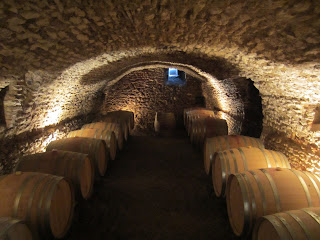 |
| Cellars in Sancerre |
 |
| The soil profile of one of the vineyards |
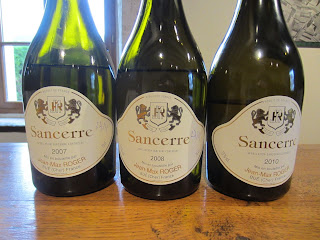 |
| Three different vintages of the top wine from Jean-Max Roger |
 |
| Some of the fermentation tanks at Henri Bourgeois |
 |
| Orders waiting to go all over the world |
All things bright and beautiful (Sancerre, France - Day Two)
 |
| Always work to be done in the vineyards |
28 Nov 2012
Personality plus (Sancerre, France - Day One)
 |
| The Sancerre Centre |
Labels:
Alphonse Mellot,
Domaine de Moussieres,
Europe,
France,
Intrepid Wino,
Loire Valley,
Sancerre,
Wine,
Wine Travel
Location:
18300 Sancerre, France
24 Nov 2012
Moullieux out (Vouvray, France – Day Two)
 |
| The cellars of Bernard Fouquet |
Straddling the Loire (Vouvray, France – Day One)
 |
| Did I mention how cold it has gotten? |
23 Nov 2012
A red dot in a sea of white (Chinon, France)
 |
| Chateau de Chinon |
22 Nov 2012
The Vintage Experience
 |
| Picking grapes in the Rheinhessen |
21 Nov 2012
Vintage 2012 - Weeks 8 & 9
My final two weeks of vintage were for the most part uneventful as the harvest concluded and the vast majority of work was cleaning and checking the fermenting tanks. I was very generously taken out for dinner and lunch by the domestic sales manager and the owner respectively, and on both instances got to eat some lovely German food. There were a couple of dinners to celebrate the end of vintage; first with the Romanian vineyard workers and then the cellar team who are all locals. The winery also welcomed a journalist and they opened some bottles going back to 1983, all of which I had the chance to taste as well.
 |
| Bernd working hard pressing botrytised fruit to get juice with high sugar content. |
 |
| Niklas compacting grape marc for future distillation to make schnapps. |
 |
| Range of wines tasted going back to 1983. |
 |
| Freshly and heavily hand-pruned vines in the Scharzofberg vineyard. |
 |
| Old shoots clinging to the trellis wire. Always reminds me of snakes. |
 |
| Just so you know who owns this vineyard. |
 |
| This is Alexandra, one of the Romanian friends I made in the vineyards. |
 |
| Walking up those steep slopes pruning requires a rest break. |
4 Nov 2012
Impressions of Germany, better late than never
It occurred to me having returned to Germany to work the vintage at a few wineries that after spending about four weeks here back in February, including attending the Prowein trade fair in Dusseldorf, I had neglected to write my general thoughts about wine here. It is a strange feeling returning to wine regions that I visited about seven months ago since travelling to regions all over Europe, particularly the Mosel which was the first region I hadn't visited before in Europe. In spite of the gap things seem very familiar, and I am often reminded of some of the things I noticed. Now I am better able to compare Germany with other countries I have visited and commented on in Europe, so it seemed like the perfect time to chronicle my thoughts.
Vintage 2012 - Week Seven
Week two at Kesselstatt was mostly the same as the first. The fruit coming in is of a very high quality, but unfortunately it is in quite small quantities. With the very cool and wet weather we have been having the ripeness is not as high as Wolfgang would like, but they are very healthy bunches with little rot. It is nice to get into a routine of checking the ferments followed by transferring filtered juice into fermentation tanks each day, but it can also be a little dull doing the same thing every day. Such is the beauty and the curse of working exclusively with white wine, as they require much less work than reds. Some of the days have been a bit shorter with much less work to do in the winery as a by-product of lower volumes but healthy fruit. Thursday was a holiday in Germany and Wolfgang was nice enough to take the team to a local restaurant for some hearty schnitzels.
 |
| Gorgeously ripe berries in the vineyards opposite Schloss Marienlay, covered in morning condensation. |
 |
| Schloss Marienlay, the headquarters of Reichsgraf von Kesselstatt. |
 |
| The Piesporter vineyards in the heart of the Mosel Valley. |
 |
| The famous blue slate soils of the Mosel. |
Vintage 2012 - Week Six
Here I am in the Mosel region, based in the Ruwer Valley just outside of Waldrach. I've now been working at Kesselstatt for about ten days and it has been great so far. Almost all of the fruit has now been picked from their numerous vineyards, and every day I get to check the progress of the tanks fermenting. The winemaker Wolfgang Mertes (who has also generously provided me with a great room whilst I am here) prefers spontaneous fermentations, some of which take a week to start. Before they start fermenting the rieslings can have a character of sweet tea to them, which is quite unique and delicious. Some of the weisburgunder tanks are fermenting really slowly but show great character because of it. It has been getting colder, sometimes raining and even a bit of snow. I picked grapes my first day and also had the chance to visit some of the other vineyards.
 |
| Vineyards overlooking Trier, the town where the Ruwer and Saar valleys join the Mosel valley. |
 |
| Where I am staying in the Mosel. |
 |
| The vineyards above Kasel the first day of work, beautiful day and actually got a bit warm in the afternoon. |
 |
| The Saar vineyard of Scharzofberg. |
 |
| Bins of fruit freshly delivered to the winery. |
 |
| The bins are lifted off the ground or off the back of trucks. |
 |
| They are then emptied into the destemmer and the berries are pumped up to the hoppers. |
 |
| Berries are free run juice go into the hoppers. |
 |
| The hoppers are then emptied into one of the presses below. |
 |
| The pressed juice gets transferred to tanks for settling overnight and racking off sediment the following morning. |
 |
| Flotation filtering is used to separate additional solids in the juice before it goes into fermentation tanks. Here we can check to see when the clear juice becomes sediment. |
 |
| Tanks must be cleaned thoroughly. This is Simon. |
1 Nov 2012
Vintage 2012 - Transition
Many apologies for the delay in posting, but as the title suggests I have moved from the Rheinhessen to the Mosel, where I am completing my vintage experience at Reichsgraf von Kesselstatt. Kesselstatt is one of the most important producers in the Mosel, owning 50 hectares of vineyards in the Mosel, Saar and Ruwer valleys. Unfortunately I have had limited access to the internet, and thus it has been very difficult to post on the blog. Here are the remaining photos from my time at Gunderloch, and future posts will be catching up from the first week or two at Kesselstatt.
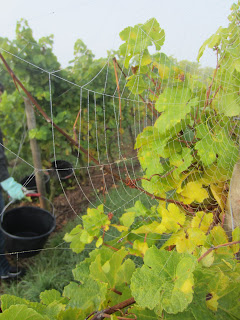 |
| Quite a beautiful sight in the vineyards. |
 |
| Spectacular view of the varying levels of leaf colour change. |
 |
| Paul Dietz from Sydney, who took over from me at Gunderloch, taking a sample from the tank the hard way. |
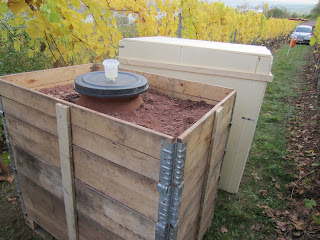 |
| The baby about to start fermenting. |
 |
| Paul and I sharing a beer at Oktoberfest in Mainz. I have since lost the beard. |
Location:
Waldrach, Deutschland
Subscribe to:
Comments (Atom)
